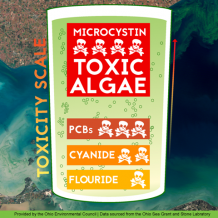Press Release
Tagged In: Clean Water, Great Lakes, Lake Erie
Groups Pledge to Help Officials Curb Pollution for Clean Lake Erie & Safe Water
Ohio Environmental Council, July 29, 2015
 On eve of Toledo drinking water crisis anniversary, groups offer support and recommendations to Ohio, Michigan governors, Ontario premier, to meet historic commitment to protect Lake Erie, public drinking water.
On eve of Toledo drinking water crisis anniversary, groups offer support and recommendations to Ohio, Michigan governors, Ontario premier, to meet historic commitment to protect Lake Erie, public drinking water.
One year after nearly half a million Toledo area residents were left without safe drinking water for almost three days because of a harmful algal bloom in western Lake Erie, conservation groups and charter boat businesses are urging elected officials to maintain momentum in efforts to curb phosphorus pollution that feeds toxic algae and to protect the region’s drinking water. The groups submitted letters Monday to Ohio Gov. John Kasich, Michigan Gov. Rick Snyder, and Ontario Premiere Kathleen Wynne offering recommendations to help meet the leader’s historic commitment in June to reduce algal-bloom-feeding phosphorus into Lake Erie.
“The memory of Toledo’s drinking water crisis, like the burning of the Cuyahoga River, will forever remind the nation that we dare not drop our guard to protect Lake Erie and our drinking water,” said Adam Rissien, Director of Agricultural and Water Policy at the Ohio Environmental Council. “We are ready to work with Governor Kasich to ensure our Great Lake water is swimmable, drinkable and fishable today and for future generations.”
In June, the governors of Ohio and Michigan and the premier of Ontario signed an agreement to restore Lake Erie by reducing the amount of phosphorus flowing into western Lake Erie by 40 percent by 2025. Included in the agreement is a commitment to develop a plan, with stakeholder involvement, that outlines how each state and the province will achieve this goal. The landmark agreement followed important steps to reduce algal-bloom-feeding phosphorus entering Lake Erie. Notably, Ohio enacted laws to protect Ohio’s waters by limiting restricting when agricultural producers can apply manure and fertilizer to farm fields. This came after action from the previous year when Ohio required most farmers to be trained and certified to apply commercial fertilizer.
Polluted run-off from farms is the number one cause of harmful algal blooms like the one last summer that contaminated Toledo’s drinking water. Rain and snow melt causes fertilizers and manure (which is rich in phosphorus) to run off farm fields and into local streams, rivers and eventually Lake Erie and smaller inland lakes. Excessive phosphorus leads to massive algae growth and harmful algal blooms, which produce toxins that can kill fish, birds and other wildlife, as well as sicken—and in rare cases kill—people.
“A year ago, a shocking event occurred: a major Great Lakes city had to ban drinking the water supply it draws from the lakes. It is unacceptable for Lake Erie – or any Great Lake – to be so polluted that it becomes a threat to public health,” said Joel Brammeier, president and CEO of the Alliance for the Great Lakes. “We are pleased that our elected leaders have made the commitment necessary to clean up Lake Erie. Now we are marking this unfortunate anniversary to remind our leaders and all the people of the Great Lakes that delivering on a commitment means showing measurable progress every year until Lake Erie is once again safe for everyone.”
Included in the recommendations is a call for wide public engagement to better inform the development of plans to meet the phosphorus reduction goal. Groups also urged for more precise identification of where agricultural pollution originates to better stop it at its source, and for annual reporting to demonstrate progress.
“It’s time to secure long-term protections for Lake Erie,” said Mike Shriberg, Great Lakes Regional Executive Director for the National Wildlife Federation. “Our elected officials have set a strong goal and we are ready and able to help them meet that goal through effective and efficient solutions.”
“Lake Erie’s sport fishing industry needs a strong and complete plan that will prevent continued harmful algal blooms,” said Captain Paul Pacholski, President of Lake Erie Charter Boat Association. “We appreciate the commitment of the 40 percent reduction and expect that specific recommendations are included in the implementation plan.”
The latest forecast from the National Oceanic and Atmospheric Administration and other experts are that this season’s harmful algal bloom in western Lake Erie will be among the most severe in recent years. Forecasts further suggest the vexing problem of harmful algal blooms will only get worse, especially if the region continues to experience heavier spring rains due to climate change.
“The cause of toxic algae is not a mystery; urban and rural fertilizer run-off, manure leaching, leaky septic systems and human sewage overflows are the primary pollution sources. Responsible farmers have piloted practices to curb runoff that all farmers need to adopt. Homeowners need to do their part too and cities should use best practices to prevent excess urban nutrient releases and storm-sewer overflows,” says Ann Keefe, Lake Erie Conservation Coordinator of the Ohio Sierra Club.
Commitments are laudable, but they need effective implementation. To ensure the 2025 deadline is met, Ohio, Michigan, Indiana and Ontario must identify the specific sources of phosphorus pollution to western Lake Erie and build on existing monitoring work to develop and implement a measurable, reportable and verifiable water quality monitoring system that can be used to determine whether reductions in phosphorus are being achieved.
“All levels of government have worked for real progress to ensure safe drinking water, including better testing, treatment, and standards,” said Sandy Bihn, Executive Director of Lake Erie Waterkeeper. “The problem continues to be getting accountability for source reduction, which has to happen with the 40% Lake Erie reduction target.”
See here for the letters to Governors Kasich, Snyder, and Pence, and Ontario Premier Wynn.
